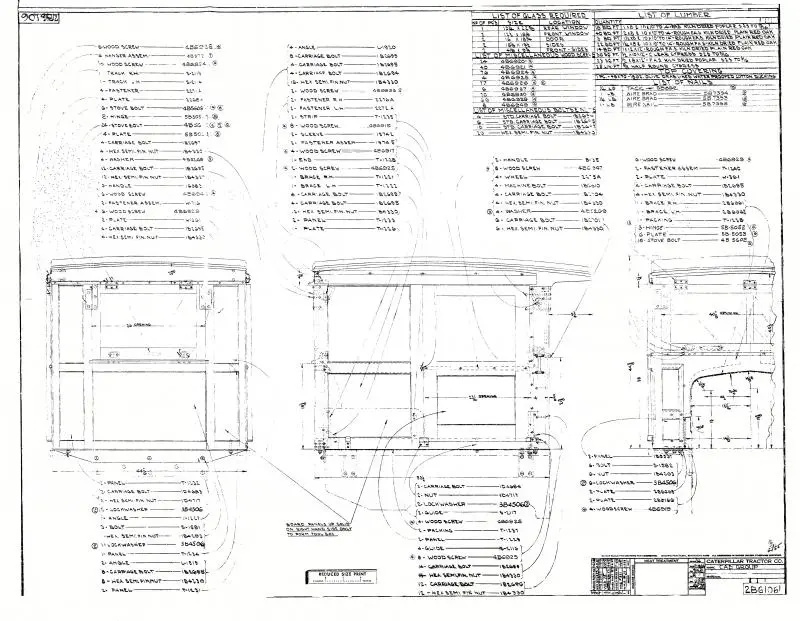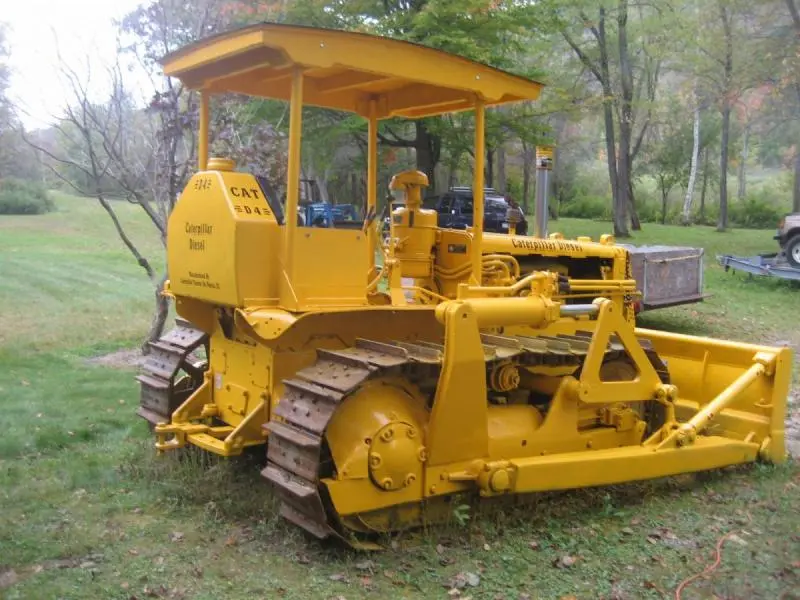The 1935 special attachments catalog says , Caterpillar cabs are durably built of heavy oak , reinforced with steel corner brackets and sheet steel panels. The roof is covered with high quality waterproof duck,securely fastened and painted.Doors slide easily on rollers which run on steel tracks. Large front and rear windows open. The wood I'm using for my cab project is going to be quarter-sawn and rift sawn white oak.

This might help. I've been trying to make it more readable as time allows. If you can't read the upper right corner, it says red oak. It also calls for cypress for some parts and poplar.
I built the cab for my 22 out of white oak before I found this.
Pete
[attachment=51894]2B6106-01 wood cab plans.jpg[/attachment]
[quote="Peter C"]This might help. I've been trying to make it more readable as time allows. If you can't read the upper right corner, it says red oak. It also calls for cypress for some parts and poplar.
I built the cab for my 22 out of white oak before I found this.
Pete
[/quote]
I find it interesting that they used Red Oak. Maybe they did not have a decent reasonably priced supply of White Oak. Strength was probably not a consideration as either would easily support the cab structure. Poplar is light and quite strong when dried but even with nice straight logs it can get a lot of twist in the lumber as it dries. It will often lift the lumber pile off the stickers when air dried as it twists. Now most folks that use Poplar lumber dry the logs for a year and then saw the lumber. It seems to solve the twist problem.
This topic was discussed on here many years ago when I built a canopy top for a Gas 70. The consensus at the time was white oak. I used red oak and patterned it after one from an early 2U D8. B4D2 also built some of those at that time. Maybe he can chime in here.
Good Luck
Biggastractor
[quote="Peter C"]This might help. I've been trying to make it more readable as time allows. If you can't read the upper right corner, it says red oak. It also calls for cypress for some parts and poplar.
I built the cab for my 22 out of white oak before I found this.
Pete
[/quote]
I find it interesting that they used Red Oak. Maybe they did not have a decent reasonably priced supply of White Oak. Strength was probably not a consideration as either would easily support the cab structure. Poplar is light and quite strong when dried but even with nice straight logs it can get a lot of twist in the lumber as it dries. It will often lift the lumber pile off the stickers when air dried as it twists. Now most folks that use Poplar lumber dry the logs for a year and then saw the lumber. It seems to solve the twist problem.
Hi Roger, I looked at a video yesterday of a Dutch windmill-powered sawmill. The commentary said that they leave the logs in the water for 12 months to reduce the sugar content which they claimed reduced the warping as well - I think he said the timber was oak.
I dont know what i sould use originally or durability
HBOGroh, red oak will offer substantial strength, as will white oak. The difference is that white oak offers better weathering protection. A long time ago, when roofing shingles and shakes were the norm, hand split white oak shingles offered superior weather resistance. I noted that several comments suggested the use of quarter sawn oak. QS oak is indeed beautiful, but I don't think you will see any significant benefit from the added cost. In fact, sometimes the QS oak will be more prone to splitting along the grain at edges, especially if exposed to weather. The case for QS oak is that it is particularly beautiful and takes a stain and glaze well, which is important in furniture making. Regardless, any material should be painted or varnished for protection. The Cat cabs were typically painted to offer protection, particularly the canvas "roofing" cover. I built a red oak cab for Alan Smith many years ago, and it still resides atop the Diesel Thirty Five that now resides in Wisconsin. Although it has weathered a bit, it is still stable and durable. Of note, if you decide to go the "au naturel" route and use a clear sealant, be aware that although there are "exterior" polyurethanes that will resist moisture, they are not UV stabilized, so you will eventually see the wood deteriorate as the wood fibers react to the UV rays (fading and bleaching of the grain). I would recommend the use of spar varnish as it is UV stable and will protect the wood from exposure better. Regards the canvas cover, Alan opted for "Sunbrella" instead of canvas. It was water proof and came in a variety of colors. His choice, of course, was yellow.
